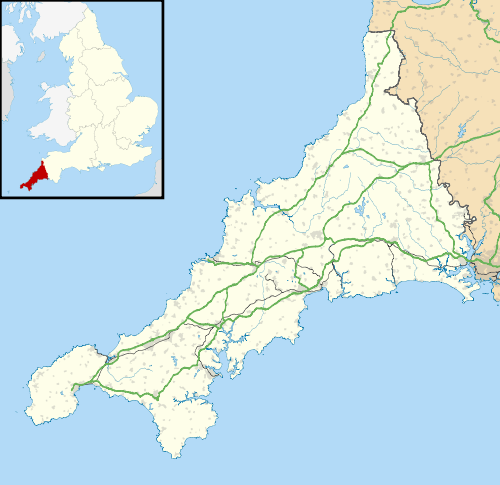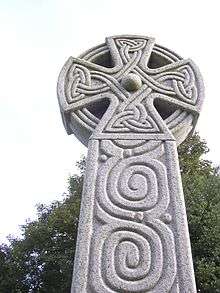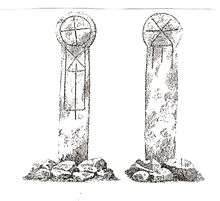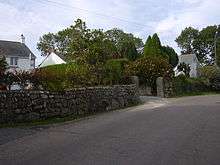Constantine, Cornwall
| Constantine | |
| Cornish: Lanngostentin | |
 Constantine |
|
| Population | 1,789 (Civil Parish, 2011) |
|---|---|
| OS grid reference | SW732291 |
| Civil parish | Constantine |
| Unitary authority | Cornwall |
| Ceremonial county | Cornwall |
| Region | South West |
| Country | England |
| Sovereign state | United Kingdom |
| Post town | FALMOUTH |
| Postcode district | TR11 |
| Dialling code | 01326 |
| Police | Devon and Cornwall |
| Fire | Cornwall |
| Ambulance | South Western |
| EU Parliament | South West England |
| UK Parliament | Camborne and Redruth |
Coordinates: 50°07′05″N 5°10′26″W / 50.118°N 5.174°W


Constantine (Cornish: Lann Gostentin, meaning church enclosure of St Constantine) is a village and civil parish in Cornwall, England, United Kingdom. It is situated approximately five miles (8 km) west-southwest of Falmouth.[1] The electoral ward also bears the same name but includes Budock Water and the surrounding area. The population at the 2011 census was 4,709 in the ward whereas the civil parish had a population 1,789 only[2] The parish of Constantine is bounded by the parishes of Mabe, Mawnan, Gweek, Wendron and the north bank of the Helford River.[3]
Constantine is named after Saint Constantine, a 6th-century Cornish saint possibly identified with a minor British king Constantine.
History
In pre-historic times, a fogou was constructed near Trewardreva: no-one knows its purpose.
The ancient name of Constantine, "Langostentyn", implies that the settlement was monastic, with the "Lan" prefix. Dr Lynette Olson (1989)[4] has examined literary and archaeological evidence for all early monastic establishments in Cornwall and found significant doubts about the religious nature of Constantine before the Norman Conquest.
After the Norman conquest
Little remains of the Norman church, which was rebuilt between 1420 and 1480: the tower has been called impressive.[5] There is a brass of 1574 to Richard Gerveys and family. The chancel was rebuilt in 1862 and there was other restoration work between 1859 and 1901.[6] One restoration (costing £1,200) commenced in 1874, with the re-opening ceremony held on 22 January 1879 by Edward Benson the Bishop of Truro.[7]
Andrew Langdon (1999) lists twelve stone crosses, or parts of crosses located in the parish. One of these was carved and erected in 1991. Several have been transferred from other sites. The stone cross at the cross-roads in High Cross was found in 1992 and re-erected nearby.[8]
The land holdings in the parish were the manors of Polwheveral, Trewardreva, Merthen (also a tithing and barton), Tucoys (also a tithing), Treworval and Treviades; the barton of Bonallack; and Trenarth and Budock Vean.[9] Trewardreva Manor House was built circa 1600 and remodelled in 1719–49; the west wing was demolished in 1860.[10] It is now Grade II* listed.
Extractive industries
The settlement called Constantine Churchtown grew up around the church. Mineral extraction led to a massive increase in population and the village expanded down what is now called Fore Street, during the 19th-century.[11] However, one property, "The Bow Window", is thought to be a 300-year-old farmhouse.
The villageparish had three main industries: agriculture; mining for tin and copper, and iron;[12] and quarrying granite.[13][14]
The largest mine was Wheal Vyvyan, which was worked from 1827 to 1864. The production figures for copper 1845–1864 and for tin ore, 1855–1864, are given in Cornish Mines.[15] The value of copper raised peaked in 1845, 1850 and 1855. The peaks of value in tin ore production were in 1856 and 1863. In 1864, the value of tin raised was only a quarter of the previous year's value and the mine closed.[16]
Twentieth-century
In 1921, Alice Hext of Trebah gave the playing field and sports pavilion to the village,[17] in memory of her husband, Charles Hawkins Hext, who died in 1917. She supported the development of the Sport and Social Club until her death in 1939.[18]
In 1933, overhead cables, providing electricity to homes were installed in the village.[19]
Port Navas has an ancient oyster farm.[20]
Government and politics
Constantine Parish Council has prepared a Parish Plan as a framework for future development/conservation.[21]
Twinning
Like many other Cornish places, Constantine Parish with Gweek, is twinned with a partner in Brittany in western France. In this case the village is twinned with Pont-Croix, Département Finistère. In Breton, "Pont-Croix" is "Pont-e-kroaz" and, colloquially, "Ar Pont".[22]
Education and language
A British School was opened in 1836 at Ponjeravah.[23] After 1957, the school moved to what is now the Church Hall and in 1966 to its present site, the building being refurbished and extended in 2005, as Constantine Primary School.[24] There is also a pre-school,[25] set in an eco-friendly building on the primary school campus. For secondary education, children have to travel to Helston, Mullion, Falmouth or Penryn.
Constantine parish is the home of five bards of the Cornish Gorseth, including a former Grand Bard, Vanessa Beeman.
Cultural activities
A social enterprise, Constantine Enterprises Company,[26] bought the former Methodist chapel in 1998. A wide range of social and cultural events happen there, all run by volunteers.The building is now known as the Tolmen Centre.
The Tolmen Centre has hosted three editions of an international guitar festival,[27] that has attracted a range of concert performers including the Silesian Guitar Octet, Mick Abrahams, Andrea Dieci, Ben Salfield (who also directed the three festivals) and Stonephace (featuring Adrian Utley and Larry Stabbins).
The village has a number of choirs and a Silver band.
In September 2006, Constantine won the Calor Best Village in Cornwall 2006 competition.[28] Constantine was also judged the Best Village in the West of England 2007, in the Business Category.
Annual events
Saint Constantine's "Feast" is celebrated in the village, on or around 9 March. The Agricultural Society (founded 1900) and the Cottage Garden Society run shows early in July. The Constantine Social Club runs a carnival, usually on a weekend at the end of July. The Constantine Art Society has a two-week exhibition, starting at the end of July. An annual "Cornish Talk and Taste" festival takes place in January.
Place-names in the civil parish of Constantine

Bonallack, Bosahan, Bosanarth, Bosawsack, Bosvathick, Boswarch, Boswidjack, Bridge, Brill (a hamlet to the west of the village of Constantine), Brillwater, Calamansac, Carvedras, Goongillings, Groyne Point, High Cross, Job's Water, Lestraynes, Maen Pern, Merthen, Nancenoy,Penbothidno, Penwarn, Polpenwith, Polwheveral, Ponjeravah, Port Navas, Retallack, Scott's Quay, Seworgan, Trebarvah, Trecombe, Tregantallan, Treglidwith, Treleggan, Trenarth, Trengrove, Tresahor, Tresidder, Trevassack, Trevease, Treviades, Trewardreva, Trewince, Treworvack, Treworvall, Tucoyse.
Notable residents
- John Hellins F.R.S., the mathematical astronomer, was curate of Constantine from 1779 to 1783.[29]
- Vanessa Beeman, Grand Bard of Gorseth Kernow September 2006 to September 2009.[30][31]
Notes
- ↑ Ordnance Survey: Landranger map sheet 204 Truro & Falmouth ISBN 978-0-319-23149-4
- ↑ "2011 Census".
- ↑ For a map of the boundaries, zoomable to plan detail, use Cornwall County Council's Interactive Map of Cornwall.
- ↑ Early monasteries in Cornwall, page 105
- ↑ Harris, Ida and David (1975). The Church of Saint Constantine in Cornwall: a brief guide, compiled and illustrated by Ida and David Harris.
- ↑ Pevsner, N. (1970) Cornwall; 2nd ed. Penguin Books; pp. 55–56
- ↑ "Falmouth". The Cornishman (28). 30 January 1879. p. 5.
- ↑ Stone Crosses: Andrew Langdon (Dyffresyas Crowson – Protector of Crosses) Stone crosses in West Cornwall (including The Lizard), The Federation of Old Cornwall Societies, 1999 (Cornish Cross series No.5) ISBN 0-902660-28-4. Langdon hold that place-names starting "Lan" indicate the location of a Burial Ground, not a church or monastery (P.3, section d). The items listed in the book in Constantine are numbered 18 to 29.
- ↑ Henderson, Charles (1937). A History of the Parish of Constantine in Cornwall. Truro: Royal Institution of Cornwall; pp. 71–210
- ↑ Pevsner (1970); p. 56
- ↑ Ordnance Survey 6-inch map, 1888, surveyed in 1878 Sheet LXXVII NW shows the street complete.
- ↑ Mining history at Constantine Village website
- ↑ history at Constantine Village website
- ↑ See also pages 44–49 of the Book of Constantine. For more information on quarrying in the Constantine area, see Peter Stanier's South West Granite
- ↑ Cornish Mines
- ↑ The story of the local mines is covered in detail in pages 40–43 of the Book of Constantine
- ↑ The book of Mawnan (2002)
- ↑ Minute Book of the Constantine Sport and Social Club (in private hands); review of the year 1940
- ↑ Electricity supply: West Briton, 17 November 1933.
- ↑ Constantine Village website on Oyster farming at Port Navas
- ↑ Constantine Parish Council information
- ↑ Constantine Twinning Association webpage
- ↑ Notes on Schools in Constantine 1957
- ↑ Primary School website
- ↑ Pre-school website
- ↑ Constantine Enterprises Company website
- ↑ http://constantinecornwall.com/tolmenguitarfestival/; http://www.highbeam.com/doc/1P2-29751231.html
- ↑ Calor Best Village Press Release
- ↑ Oxford Dictionary of National Biography article by R. E. Anderson, 'Hellins, John (d. 1827) ', rev. Adrian Rice, accessed 30 May 2007
- ↑ kw:Vanessa Beeman
- ↑ "Cornish Gorseth site". Gorseth Kernow. Retrieved 16 December 2009.
References
- Trethowan, Gerald; Moore, Liz (2001). The Book of Constantine. Tiverton, Devon: Halsgrove. ISBN 1-84114-102-X.
- Henderson, Charles (1937). Doble, G. H., ed. A History of the Parish of Constantine in Cornwall. Truro: Royal Institution of Cornwall.
- Scolding, Bill (2006). Five walks around Constantine. Constantine, Cornwall: Constantine Enterprises Company. ISBN 978-0-9552816-0-0.
- Stanier, Peter (1999). South West Granite: a history of the granite industry in Devon and Cornwall. St. Austell, Cornwall: Cornish Hillside Publications. ISBN 1-900147-14-9 (Hardback) ISBN 1-900147-13-0 (paperback).
- Burt, Roger; Burnley, Ray (1987). Cornish Mines. Exeter, Devon: University of Exeter with the Northern Mine Research Society. ISBN 0-85989-287-5.
- Olson, Lynette (1989). Early Monasteries in Cornwall. Studies in Celtic History. Woodbridge, Suffolk: Boydell Press. ISBN 0-85115-478-6.
- The Mawnan History Group (2002). The Book of Mawnan: celebrating a South Cornwall parish. Tiverton, Devon: Halsgrove. ISBN 1-84114-148-8.
External links
| Wikimedia Commons has media related to Constantine, Kerrier. |